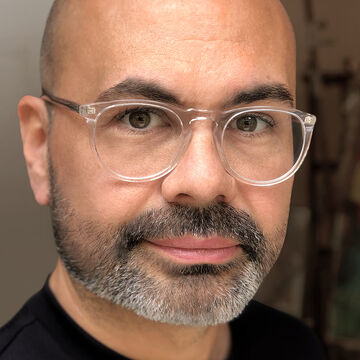

Pablo R Garcia
Associate Professor
Contact
Bio
Trained as an architect, Pablo Garcia's recent work has evolved from design-for-hire to internationally exhibited artworks, provocations and research studies. Born in 1975, Garcia was in college when the first internet browser launched. Composite training in traditional analog and then-nascent digital technologies inspired a research practice into the intersection and overlap of art and technology, obsolescence and the cutting edge, the real and the virtual. Garcia’s work ranges from scholarly contributions to art historical studies to contemporary artworks examining digital culture.
His expertise in the history and technique of drawing technologies has contributed to research for institutions such as The Art Institute of Chicago, The American Philosophical Society, The Polytechnic Museum (Moscow), and The Victoria & Albert Museum (London). Garcia has lectured and exhibited in galleries and festivals across North America, South America, and Europe. His work has also been featured in the most widely-read journals in the world, including Art in America, WIRED, FastCompany, Huffington Post, GQ, Mashable. Garcia's Core77 Award winning NeoLucida (in collaboration with Golan Levin) was among the Top 100 highest grossing Kickstarter campaigns of all time. Previously, Garcia has taught at Carnegie Mellon University, Parsons School of Design, and The University of Michigan. He holds degrees in architecture from Cornell and Princeton Universities.
Personal Statement
Why is 'virtual' often synonymous with 'digital'? I suspect that the term 'virtual reality' had something to do with it, as when it was coined in the early 1990's new visions of digitally-driven immersive experiences invaded popular culture. Star Trek: The Next Generation, The Lawnmower Man, Max Headroom, and similar media exploited early digital technologies to imagine a future of complex virtual environments.
But "virtuality"—the systematic approximation and representation of reality—existed long before computers. The adjective “virtual” has been in continuous use since the 15th century, and derives from post-classical Latin virtualis—possessing certain physical virtues. Adding the suffix "-al"—of or relating to that which is denoted by the first element, as in global, palatial, sexual—renders a broader and more applicable definition of “virtual”: “Senses relating to essential, as opposed to physical or actual, existence." To wit: “physical-like”, or “real-ish.” With this definition, virtuality not only existed before computers, but it would seem that humans have always been virtual. Early mathematics and painting relied on shadows—real-time projected images, and Renaissance painters sought verisimilitude with linear perspective. Our long pursuit of virtual technologies now meets a perfect engine in computation.
Caught in between two paradigms, I found myself nurturing two separate impulses: deep historical research into old, forgotten technologies and inquiry into new and future media. My resultant body of work reflects a process which is part reverse-engineering, part laboratory, part research art practice. And this interest is free of disciplinary constraint; I work across a wide variety of processes and media: design objects supported by crowd-funded initiatives, video/performance pieces, mechanized sculpture, fusions between the newest technologies and ancient techniques and site-specific installation art (Windows).
In all of these speculative virtualities, the at-times forgotten connections between history and the future play major roles. Research and reverse engineering are critical tools I use to explore how our rich past informs our future technologies.
Works in Vimeo
The NeoLucida Project, 2013-Present, A modern reinterpretation of the camera lucida, a 19th century optical drawing tool that lets you trace what you see.
Profilograph (after Muybridge), 2008, Plate 624 (Horse in Motion) from Eadweard Muybridge's Animal Locomotion (1887), transformed by what I call PROFILOGRAPHY-a method of tracing and extrusion through sequential profiles. Digital modeling tools turn twelve original photographs into a single solid. That solid becomes 3D printed parts made for bronze investment casting in a process invented for this project.
Profilograph (after Dürer), 2008, Studies in male profiles, from Albrecht Dürer's Vier Bücher von Menschlicher Proportion (Four Books on Human Proportion) (1528), transformed by waht I call PROFILOGRAPHY-a method of tracing and extrusion through sequential profiles. The machine is made from 3D printed shells, mounted to a laser-cut aluminum structure, rotating on a motorized spindle.
Windows, 2011, Installed for "Gestures: Intimate Friction" at the Mattress Factory Art Museum, Pittsburgh.
Memento Mori (Catoprtric), 2012, Little skulls placed around town to remind you: THOU ART MORTAL.
Machine Drawing Drawing Machines, 2011, In which twelve drawings of historical drawing machines are drawn by a computer numerical controlled machine.
Memento Mori (Tattoo), 2010-2017, A temporary tattoo you can use to remind everyone: THOU ART MORTAL.
Memento Mori, and other Selfie Stick Add-ons, 2015, Using principles of anamorphosis, or obliquely distorted perspective, the printed graphics are applied to the selfie stick. The smartphone camera is the only vantage point capable of decoding the image, inserting a graphic into your selfie. Perhpas it's a sober reminder of your mortality in the midst of your vainglory, or simply a pile of poop with eyes.
iPhone Panoramas, 2011-12, Unfiltered and unedited iPhone Panoramas, shot on location using only the iOS7 Panorama App with an iPhone 5.
Webcam Venus, 2013, In Webcam Venus, we asked online sexcam performers to replicate iconic works of art. This piece is an experimental homage to both fine art and the lowbrow internet phenomenon of cams. Sexcams use webcams and chat interfaces to connect amateur adult performers with an audience. Users log on to see men, women, transsexuals, couples and groups broadcast their bodies and sexuality live for the public, often performing for money. To create this experiment in high and low media, we assumed anonymous handles and spent a few hours each day for a month asking performers: "Would you like to pose for me?"